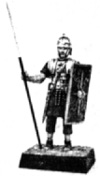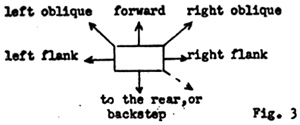 Quite a while back, sometime in 1968, I penned a series
of rules for Roman Civil War battles that appeared in the
Newsletter. Unknowingly, a cohort of mine also sent the same
article to an American publication. Belated apologies for that.
Since then, and a year or so in Vietnam in between, further
research has caused several adaptations and innovations to be
made. As I proceed along this path, the reader will note the
disagreements and incongruities that abound when researching
this field.
Quite a while back, sometime in 1968, I penned a series
of rules for Roman Civil War battles that appeared in the
Newsletter. Unknowingly, a cohort of mine also sent the same
article to an American publication. Belated apologies for that.
Since then, and a year or so in Vietnam in between, further
research has caused several adaptations and innovations to be
made. As I proceed along this path, the reader will note the
disagreements and incongruities that abound when researching
this field.
I won't repeat my previous article, but will discuss it, and note the changes and reasonings thereof. The principle excuse for this delay of the article, will have to be my induction into the U.S. Army in early 1969. I am sure it is easy to imagine why I have not had a great deal of time to wargame or write since that time.
My organisation of the Legion is basically correct as a "Julian Legion", that is, a Legion under the Marian Organisation. However, just who or what commanded this Legion, is still a question. Sir James Turner (1683) in his PALLAS ARMATA military essays, concludes, after reviewing the various possibilities, that it is probably the Tribune, with each of six rotating monthly in command, thus enabling each Tribune to command the Legion. That normally would make sense, as the Legion's command would not fall to one Tribune only, but rather each would gain the experience to command. However, Tribunes, normally sent to the Legions on political appointment, were not required to have any prior military experience.
The tres militiae (three steps of military career) began with Tribunus militum, went to a cavalry command, Praefectus equitum, and then Legatus, which could be a Legion command, although not necessarily. I cannot believe that command of a unit as large as a Legion would be entrusted to a Tribune with little or no prior experience.
The next to consider as a possibility, is the Legatus Legionis, the "Legati Augusti." This rank, as supported by Vegetius Renatus and Sheppard Frere (author of many works on ancient Rome, including BRITTANIA: A History of Roman Britain) translates to "adjutant" or Assistant. It is fact, that Caesar gave command of his Legions to Legates, when these personnel were available. A shortage of these men prevailed in Caesar's Army, that of Pompey, and that of Plautinus and Scapula in Britain, to name but a few.
It is my opinion that the Legate was given the POSITION of Legion Commander, not to his "own" Legion, but rather to "a" Legion, when and if the Governor or General saw fit. Ordinarily, more Legions prevailed than did Legates, but when possible, Legates DID command the Legion. The Tribunus Laticlavius, the senior Tribune, would command in lieu of a Legatus. The last possibility is that there was a Praefectus Legionus (literally, "commander of Legion") as mentioned by Turner. Highly unlikely that a "rank" as such existed. Probably a "position" rather than a grade or rank. Various "titles" for the same position are not uncommon.
Strangely enough, pouring over Tacitus' Histories, Polybius and Livy gives great insight into the operations and such of the Legion, but try to gain information concerning command networks or even uniforms, and you hit an impasse. When it comes to the question of who exactly is commanding this Legion, no definite answer is to be found. The additional problem of the Cohort Commander also rears it's ugly head. I have taken the Centurio Princeps as the Cohort Commander, a senior Centurion.
The formations employed are the same: Testudo; Cohort Column; Phalanx; Pincer; Wedge; Orbis; Lone Century; Disarray; plus a new one, that of Skirmish. That applies to Light troops only, and is simply a half Century stand. Of course, these formations have names that may be more appropriate, so I will list the various formations with their synonyms.
- TESTUDO: tortoise, turtle.
COHORT COLUMN: quadrate, simple lateritial quadrate, aequilateral quadrate.
PHALANX: quadrate turrite.
PINCER: tenaille, tongs.
ORBIS: globe.
 My Phalanx, or more properly, a Quadrate Turrite, consists of two cohorts in column. That
is: twelve centuries, back to back, in this fashion. (Fig. 1). A variation on this would be two cohorts side by side, termed a "flying Lateritial". (Fig. 2). However, this would not have the effect of a phalanx, as it is only six ranks deep, and a Phalanx must be twelve.
My Phalanx, or more properly, a Quadrate Turrite, consists of two cohorts in column. That
is: twelve centuries, back to back, in this fashion. (Fig. 1). A variation on this would be two cohorts side by side, termed a "flying Lateritial". (Fig. 2). However, this would not have the effect of a phalanx, as it is only six ranks deep, and a Phalanx must be twelve.
Movement, for the most part, remains the same. Units in Disarray may no longer move. Light troops (in Cohort Column, Lone Century, and Skirmish only) move 24". Light Cavalry move 30", and Heavy Cavalry move 24".
Generally, I must admit, I am in a muddle over Cavalry. Though never my favourite arm, references, in any of the source books I have encountered, including even Caesar's narrative of the Gallic Campaigns, describe very little of any tactics employed by the Cavalry If any can help me on this, or can suggest any references I can go to, I would appreciate it.
In the order of movement, I have included a variation for the written orders for movement, to produce simultaneous movement. Three orders are listed. They are: Order to Move (No. of inches); Formation Employed; and Direction of March.
I am allowing only ONE order to be given by the Centurions for the march:
 Two or more orders would have to be given to execute any other direction of march. Example:
dotted line would be, Right Flank, Right Oblique.
Two or more orders would have to be given to execute any other direction of march. Example:
dotted line would be, Right Flank, Right Oblique.
Now, as to manoeuvring, I believe that in the set of rules published, there was confusion over that entire section. I will now try to straighten that out. A unit, generally a cohort beginning in the TESTUDO, obtains 10 points for that formation. To remain in that formation, consulting the chart, it is seen that 26 points are needed to assume the TESTUDO. Therefore, 16 additional points must be attained from the officers in the cohort. The Cohort standard bearer is 3 points, the Centurio Princeps (Cohort commander) is 5 points, and each Centurion is 2 points. Thus, if a Cohort is at 100% strength, it has 20 points of officers. Add this number of officer points to the formation points, and, in this case, 30 are attained. 26 are needed for the TESTUDO, therefore the Cohort can remain in that formation. If the number 0 f points were not enough to maintain the desired formation, the unit would fall into Disarray.
Note: The required points to form a Cohort Column has dropped from 22 to 20. Therefore, a unit in Orbis or Disarray can reform into a Cohort Column if 20 points of officers are present with the unit.
The combat rules have changed drastically. In a fit of insanity, I formulated the rules for Gladius combat with a die roll per man. One die roll PER CENTURY will suffice now, with 1 point required to kill a Legionary and 5 points to kill any officer. The lead Century of the WEDGE no longer get any great advantage, except that it fights as a Century.
My Cavalry rules are a take-off on Tony Bath's fine rules from the NEWSLETTER HANDBOOK Series. When Cavalry attack Infantry, the Infantry must throw to stand.
- [die roll + modifer combined must equal 10]
Die roll plus 6 points for TESTUDO
Die roll plus 8 for ORBIS
Die roll plus 9 for PHALANX
Die roll plus 7 for COHORT COLUMN
Die roll plus 5 for LONE CENTURY
Die roll plus 7 for PINCER
Die roll plus 9 for WEDGE
Die roll plus 0 for DISARRAY
Die roll plus 4 for SKIRMISH
If formation attacked in flank, deduct 2 numbers off die roll.
If 10 not met, unit is in DISARRAY, and Cavalry automatically charge home.
If Infantry stand, Cavalry must throw to charge home: Heavy Cavalry - 3, 4, 5, Light Cavalry - 4, 5, 6.
Combat dice throws: For every six points, throw die, -12 that number points killed.
- Heavy Cavalry - 3 points each.
Light Cavalry - 2 points.
Heavy Infantry - 2 points.
Light Infantry - 1 point.
In the Melee, a unit inflicting more casualties than the other, is deemed the winner of that melee round. The loser of a melee round must retire 41, at the termination of the combat turn. He is facing the enemy, and the victor has the option to follow the vanquished to his new location. For every additional rank of Heavy Infantry that an attacker has, the defender is edged back 1/2" at the BEGINNING of the combat turn. In order to successfully attack a unit in flank, that unit must also be engaged by close combat or missile fire frontally. The ORBIS and the WEDGE have no flanks. The WEDGE of course, has its' rear which is vulnerable.
I believe that this may clarify those rules that appeared a while back. These can be supplemented by Tactical and Campaign rules for Roman Campaigns in Brittannia, that perhaps will follow in a later article (I am still in the Army). The period covered is that of the year 49 A.D. 9 with the pursuit of CARACTACUS, Prince of the Catuvellauni, by the II Augusta, IX Hispana, XIV Gemina and the XX Valeria Roman Legions.
Back to Table of Contents -- Wargamer's Newsletter # 117
To Wargamer's Newsletter List of Issues
To MagWeb Master Magazine List
© Copyright 1971 by Donald Featherstone.
This article appears in MagWeb.com (Magazine Web) on the Internet World Wide Web.
Other articles from military history and related magazines are available at http://www.magweb.com